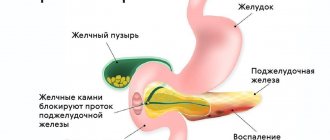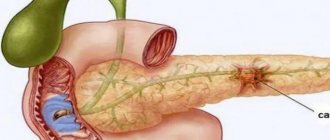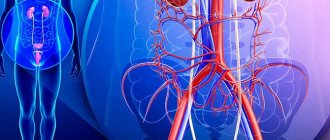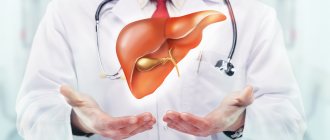UDC 616.3-089-06:616.37-002-08:615.243
The effectiveness of dalargin in the complex therapy of chronic pancreatitis that developed after gastric resection in patients with peptic ulcer was studied. A positive effect of dalargin on the clinical course of the disease and the functional state of the pancreas has been shown. The authors attribute this to the restoration of microcirculation and the antioxidant effect of the drug. According to long-term observations, the effect of therapy persisted for a year.
Evaluation of dalargin effectiveness in the treatment of postgastroresectional pancreatitis
The efficacy of dalargin in the treatment of chronic pancreatitis, which developed after stomach resection in patients with peptic ulcer disease, was investigated. The positive effect of dalargin on the clinical course of disease and the functional state of the pancreas was found. The authors attribute this to the restoration of microcirculation and antioxidant action of the drug. According to long-term observations the effect of therapy was maintained throughout the year.
Gastric resection remains one of the main surgical interventions for complicated gastric and duodenal ulcers [1]. However, after gastrectomy, 14.3-24.1% of patients develop postgastroresection pancreatitis (PP) [2, 3]. This may be a consequence of the shutdown of the antral hormonal zone and the duodenum, which play an important role in coordinating the activity of the digestive system [4, 5], as well as the result of a high load on the pancreas (P) due to its compensatory and adaptive function after gastrectomy. Prolonged pain syndrome and the development of exocrine pancreatic insufficiency significantly reduce the quality of life of patients and require serious drug therapy.
In recent years, natural peptides and their synthetic analogues have been recommended for the correction of various pathological processes, including in the pancreas. One of these regulatory peptides is the leu-enkephalin analogue dalargin [6, 7]. Clinical trials of dalargin conducted in hospital conditions demonstrated its high activity in the treatment of exacerbations of gastric and duodenal ulcers [8]. A positive therapeutic effect of the drug was noted in patients with acute pancreatitis [6, 7].
The purpose of our work is to study the characteristics of changes in the functional state of the pancreas after gastrectomy and to justify the use of dalargin in the treatment of patients with CP.
Materials and methods. We observed 50 patients with gastric and duodenal ulcers after gastric resection with subsequent development of PP, of which 27 patients underwent resection according to Billroth-1 and 23 according to Billroth-2. The study of patients was carried out from 1 to 31 years after surgery. The patients were aged from 26 to 71 years. There were 45 (90%) men, 5 (10%) women. The duration of peptic ulcer disease before surgery ranged from 1 to 39 years.
The patients were divided into 2 groups, comparable in age, severity, severity of pain, duration of pancreatitis, and frequency of concomitant pathologies: 25 patients in the observation group received dalargin daily in a dose of 1 mg intramuscularly 2 times a day as part of complex therapy, course dose of dalargin was 20-30 mg; 25 patients in the comparison group received traditional therapy, including antispasmodics, M-anticholinergics, proton pump inhibitors, and enzyme preparations.
The diagnosis was made on the basis of anamnestic, objective and laboratory data, ultrasonography, fibrogastroduodenoscopy, intragastric pH-metry and computed tomography. The exocrine function of the pancreas was assessed by the level of amylase, lipase and trypsin in the blood serum, and urine diastase; endocrine function - based on the level of insulin and C-peptide in the blood serum. Amylase in blood serum and diastase in urine were determined by the Caraway method, lipase was determined by a unified method. Trypsin, insulin and C-peptide, as well as TSH, T3, T4, cortisol and gastrin in the blood serum were determined by radioimmunoassay. The activity of lipid peroxidation processes was determined by the level of malondialdehyde (MDA) in blood serum. The state of microcirculation was assessed using conjunctival biomicroscopy at a slit lamp ShchL 2B BP according to the method of V.S. Volkova (1977).
The results of laboratory and instrumental studies of patients were compared with the data of 15 practically healthy individuals. The data were processed using the method of variation statistics; Student's t-test was used to assess intergroup differences; and the correlation analysis method was used to identify the relationship between indicators.
Results and its discussion
In the process of complex therapy with the use of dalargin, it was possible to completely relieve pain in 21 (84%) of 25 patients. A decrease in pain was observed mainly on the 3rd–4th day of therapy, and disappearance on the 5th–6th day. With traditional therapy, it was possible to completely relieve the pain syndrome in 72% of patients; the decrease in pain syndrome occurred mainly by the 5th–7th day of treatment.
Complex therapy with the use of dalargin helped to reduce or eliminate dyspeptic complaints. Nausea, a feeling of heaviness and fullness in the epigastric region disappeared most quickly in the observation group. The belching passed somewhat more slowly. An improvement in appetite was noted in 80% of the subjects in the observation group. Dalargin contributed to the normalization of stool in patients: constipation went away in all patients, mushy stool became formed. In the comparison group, nausea and bloating disappeared or decreased more slowly.
The use of dalargin clearly relieved pain on palpation of the abdominal wall in 84% of patients, in particular in the area of the projection of the pancreas, in the Shoffar, Gubergrits-Skulsky zone, but somewhat later than the reverse development of spontaneous pain syndrome.
In patients in the observation group, the basal level of blood amylase was elevated in 17.85% of cases, and decreased in 21.4% of cases. In the comparison group, an increased level of amylase in the blood serum was detected in 37.5% of cases, a decreased level - in 37.5%. In all patients with insufficient secretory function of the pancreas, ultrasound examination revealed an increase in the echogenicity of the organ structure, which indicates the development of sclerotic processes in the gland tissue as a result of previous exacerbations of the disease.
During the treatment, we observed multidirectional dynamics in the levels of blood enzymes (Fig. 1, 2).
Figure 1. Dynamics of amylase content with an initially increased level during therapy with dalargin (I) and traditional treatment (II)
Note: * - reliability in relation to the initial level;
**—reliability in relation to healthy people (p<0.05)
Figure 2. Dynamics of amylase with an initially reduced level during therapy with dalargin (I) and traditional treatment (II)
Note: * - reliability in relation to the initial level;
**—reliability in relation to healthy people (p<0.05)
In patients with a high level of amylase in the blood, its level significantly decreased during treatment in both groups; in patients with a reduced basal level of blood amylase, its increase was noted during a course of treatment with dalargin; the change in amylase level in the comparison group was insignificant (Fig. 2).
The increase in amylase levels can be explained by the stimulating effect of dalargin on pancreatic cells. Dalargin stimulates the processes of cell division and DNA synthesis, eliminates the development of erythrostasis and microthrombosis, improves microcirculation in the pancreas, and prevents the development of interacinar and intracellular edema in the intact segment of the gland [9-11].
A study of trypsin in blood serum revealed an increase in all examined patients with PP. During therapy, the concentration of trypsin in the blood in both groups decreased significantly (Table 1). Lipase activity in the examined patients was initially increased and decreased during treatment in both groups of patients.
Table 1.
Dynamics of lipase and trypsin levels in the blood of patients with PP during therapy
| Groups surveyed | Study period | Lipase (units) | Trypsin (ng/ml) |
| Comparison group | before treatment | 1,24±0,11* (n=11) | 620,2±9,8* (n=10) |
| after treatment | 0,64±0,09** (n=10) | 510,9±11,6** (n=11) | |
| Observation group | before treatment | 1,27±0,12* (n=9) | 840,6±9,8* (n=10) |
| after treatment | 0,5±0,07** (n=8) | 380,8±11,1** (n=9) | |
| Healthy | 0,78±0,14 (n=10) | 225,6±17,2 (n=10) | |
Note: n is the number of people examined;
* — reliability in relation to healthy people (p<0.05),
** — reliability in relation to the initial level
According to coprological studies, 23 patients (46%) had amilorrhea, 12 (24%) had creatorrhoea, and 7 (14%) had steatorrhea. During therapy, positive dynamics of the coprogram were noted: in the comparison group, the number of patients with creatorrhoea decreased by 50%, with amilorrhea - from 13 to 7 people, with steatorrhea - from 4 to 2 people; in the observation group, the number of patients with creatorrhoea decreased from 6 to 2 people, with amilorrhea from 10 to 4 people and with steatorrhea - from 3 to 1 person.
As the data in table shows. 2, in 55.8% of patients the insulin content in the blood was increased in comparison with healthy individuals, and in 33.2% of patients a decrease in its level was noted. A decrease in basal insulin levels was noted in patients with sclerotic changes in the pancreas identified by echography. Insulin secretion, both initially low and initially elevated, increased slightly in both groups of patients during treatment.
table 2.
Dynamics of insulin levels in the blood of patients with PN during therapy (mkd/ml)
| Group of examined people | Insulin level | Before treatment | After treatment |
| Comparison group | Initially reduced | 6,02±0,86 (n=8) | 6,92±0,41 (n=9) |
| Initially elevated | 16,25±1,25* (n=12) | 17,73±1,0 (n=10) | |
| Observation group | Initially reduced | 5,93±0,56* (n=7) | 6,46±0,41 (n=8) |
| Initially elevated | 12,88±1,06* (n=13) | 14,52±0,96 (n=11) | |
| Healthy | 8,83±0,96 (n=10) | ||
Note: n is the number of people examined;
* — reliability in relation to healthy people (p<0.05)
The ability of the pancreas to produce insulin is fully reflected by determining the concentration of C-peptide in the blood serum [12]. We did not identify significant differences in the level of C-peptide in the examined patients from healthy individuals: in the control group it was 0.3±0.09 pmol/ml, in the observation and comparison groups - 0.37±0.06 pmol/ml and 0 .34±0.03 pmol/ml, respectively. During therapy, a tendency towards an increase in the concentration of C-peptide in the blood serum was noted in both groups. The increase in insulin and C-peptide levels can be associated with the stimulating effect of therapy on islet tissue, improved metabolism of pancreatic tissue, and restoration of microcirculation. Thus, according to biomicroscopy of the conjunctiva, in the observation group the conjunctival index significantly decreased from 6.23 ± 0.68 to 4.21 ± 0.28 (in healthy people it was 1.88 ± 0.23) and in the comparison group it tended to decrease (from 6.26±0.66 to 5.33±0.44).
The gastrin level in the patients we examined was significantly higher in comparison with healthy individuals (Table 3). An increase in gastrin content in the blood may be due not only to atrophic lesions of the gastric stump mucosa, accompanied by a low concentration of hydrochloric acid, but also to a high content of trypsin in the blood, which promotes the formation of active gastrin [13]. The dependence of changes in gastrin levels on the type of therapy was established. Thus, in the comparison group there was a tendency towards an increase in its level, and during treatment with dalargin there was a tendency towards its decrease.
Table 3.
Dynamics of hormone levels in the blood of patients with post-gastroresection pancreatitis during therapy
| Group of examined people | Study period | Cortisol (nmol/l) | Gastrin (ng/l) | T3 (nmol/l) | T4 nmol/l) | TSH (med/l) |
| Comparison group | before treatment | 483,6±19,7* (n=12) | 66,86±7,5 (n=9) | 1,58±0,13 (n=11) | 118,2±9,8 (n=10) | 1,81±0,32 (n=8) |
| after treatment | 398.9±23.8 (n=9) | 71,95±4,9 * (n=10) | 1,81±0,17 (n=10) | 99,9±11,6 (n=11) | 1,7±0,29 (n=7) | |
| Observation group | before treatment | 480.3±21.7* (n=10) | 76,3±3,8* (n=7) | 1,8±0,09 (n=9) | 120,6±9,8 (n=10) | 2,31±0,41 (n=7) |
| after treatment | 461,2±18,0* (n=11) | 61,2±5,7 (n=13) | 2,01±0,2 (n=8) | 118,8±11,1 (n=9) | 2,1±0,34 (n=6) | |
| Healthy | 364,75±22,3 (n=15) | 52,8±3,91 (n=15) | 1,82 ±0,14 (n=10) | 124,68±17,2 (n=10) | 2,19±0,47 (n=10) | |
Note: n is the number of observations;
* — reliability in relation to healthy people (p<0.05)
According to our data, the basal level of cortisol in patients was higher than in healthy people (Table 3). During treatment, in both groups of patients there was a tendency towards a decrease in the level of cortisol in the blood. Considering that cortisol is one of the stress hormones [12, 14, 15], we are inclined to believe that hypercortisolemia in patients was largely of stress origin and decreased with relief of pain.
In patients, the basal level of T3 was lower, and no significant changes were noted in the content of T4 (Table 3). During treatment, an increase in T3 levels was observed in both groups of patients. The TSH level in patients with PP was practically no different from healthy individuals. The therapy in both groups of patients led to a decrease in its concentration in the blood.
The content of MDA in the blood, indicating the activity of lipid peroxidation processes, was increased in both groups of patients compared to healthy ones. After a course of therapy with dalargin, its amount in the blood decreased from 9.05±0.51 to 6.48±0.44 mmol/l (p<0.05), while in the group of patients receiving traditional therapy it changed immaterial. We attribute this to the pronounced antioxidant effect of dalargin.
To evaluate the effectiveness of therapy, according to long-term results, we monitored 31 patients for two years after the course of therapy, with 15 patients from the observation group and 16 patients from the comparison group. After hospital treatment, the patients were registered at the dispensary. Relapses of the disease occurred within two years in the comparison group in 9 (56.3%), and in patients in the observation group, exacerbation of the disease was noted in 6 (40%). At the same time, relapses of the disease in the comparison group more often occurred in the first months after discharge from the hospital and in general during the year their frequency was 43.8%. In the observation group, relapses of the disease occurred in the 2nd year after hospital treatment.
The majority of patients (39.5%) noted a violation of diet, physical activity and neuropsychic stress as the cause of relapse of the disease. In the comparison group of 9 patients with exacerbation of PP, 7 patients (77.8%) received inpatient treatment, while in the observation group 3 (50%) of 6 patients were inpatiently treated.
conclusions
1. When dalargin is included in complex therapy in patients with PP, pain and dyspeptic symptoms are eliminated or reduced, and at the same time a number of positive changes are noted in the functional state of the pancreas.
2. During therapy, the elevated levels of gastrin and cortisol in the peripheral blood decrease.
3. A pronounced antioxidant activity of dalargin was revealed, which may be one of the pathogenetic mechanisms of its therapeutic effect.
4. The use of dalargin for PP, according to short-term and long-term observations, was superior in effectiveness to traditional therapy.
ME AND. Grigus, O.D. Mikhailova, V.F. Bulychev, A.Yu. Gorbunov
Izhevsk State Medical Academy
Grigus Yan Ilyich - Candidate of Medical Sciences, assistant at the Department of Propaedeutics of Internal Diseases with a course in Nursing
Literature:
1. Zhizhin F.S., Kapustin B.B. Single-row antireflux anastomosis during tubular gastrectomy // Conference materials. "Current aspects of hospital surgery." - Izhevsk, 2000. - pp. 21-24.
2. Pomelov V.S., Baramidze G.G. Diagnosis, prevention and treatment of post-gastroresection reflux gastritis // Surgery. - 1994. - No. 5. - P. 32-35.
3. Vakhrushev Ya.M., Ivanov L.A. Postgastroresection syndromes. - Izhevsk, "Expertise", 1998. - 139 p.
4. Ugolev A.M. Enterin (intestinal hormonal) system. - Science, L., 1978, 315 p.
5. Vakhrushev Ya.M. New approaches to the study of functional connections of the gastrointestinal tract with the endocrine glands // Ter. archive. - 1985. - No. 9. - P. 98-102.
6. Georgadze A.K., Buzenkov S.V., Dzhakiya A.K. and others. Features of diagnosis and treatment of fatty pancreatic necrosis // Surgery. - 1991. - No. 4. - P. 11-14.
7. Penin V.A., Titov M.I., Titov V.N. and others. Mechanism of action and prospects for the use of a new domestic analogue of enkephalin - dalargin in the complex treatment of acute pancreatitis // Sat. scientific works "Acute pancreatitis". - Moscow, MMSI, 1986. - pp. 20-25.
8. Alekseenko S.A., Timoshin S.S. The influence of histamine and dalargin H2 receptor blockers on the reparative processes of the mucous membrane of the gastroduodenal system in patients with duodenal ulcer // Klin. honey. - 1996. - No. 9. - P. 52-54.
9. Titov M.I., Vinogradov V.A., Bespalov T.D. and others. Dalargin is a peptide drug with a cytoprotective effect // Bulletin. VKSC AMS USSR. - 1985. - No. 2 - P. 72-76.
10. Vinogradov V.A., Polonsky V.M. Dalargin is the most active synthetic analogue of endogenous opioids for the treatment of peptic ulcer disease (results of a five-year search) // Bulletin. VKSC AMS USSR. - 1986. - No. 2. - P. 62-63.
11. Ivanikov I.O., Vinogradov V.A. Results of using dalargin for pancreatitis // Mater. conf. VNOG. - Smolensk, 1991. - P. 224-226.
12. Vakhrushev Ya.M., Trusov V.V., Vinogradov N.A. Liver and hormones. - Izhevsk, 1992. - 112 p.
13. Trefflot MJ, Laugier R, Brethols A et al. Increased gastrin release in chronic calcifying pancreatitis and in chronic alcoholism // Horm. Metab. Res. - 1980. - No. 12. - R. 240.
14. Clinical endocrinology (Guide for doctors) / ed. N.T. Starkova. - M.: Medicine, 1991. - 512 p.
15. Mikhailova O.D. Endogenous intoxication in chronic pancreatitis // Ros. Journal of Gastroenterology, Hepatology and Coloproctology. - 2010. - No. 5. - P. 65.
New opportunities in pain and replacement therapy for chronic pancreatitis.
Elena Aleksandrovna Poluektova , doctor, candidate of medical sciences:
– We are returning to gastroenterology, and the message will be given by Doctor of Medical Sciences, Professor Oleg Samuilovich Shifrin “New opportunities in pain and replacement therapy for chronic pancreatitis.”
Oleg Samuilovich Shifrin , professor, doctor of medical sciences:
– Dear colleagues, the working group of the Russian Gastroenterological Association has developed recommendations for the management of patients with chronic pancreatitis. Please note that very important fundamental principles that a doctor should take into account in the management of this type of patient are indicated in red. This is the determination of the cause of pain, abdominal pain in chronic pancreatitis and its treatment. The second important area is the treatment of exocrine pancreatic insufficiency. These are the questions that form the basis of my message.
So, at the onset of chronic pancreatitis, abdominal pain occupies a very important place, this is a cardinal sign. It occurs much more often than manifestations of exocrine insufficiency, symptoms of pancreatogenic diabetes, jaundice, etc. In almost 90% of patients with various forms of pancreatitis, regardless of etiology, pain occupies a central leading place at the onset of the disease. At an advanced stage of the disease, exocrine insufficiency may come to the fore, and this is important to take into account.
Clinical example. A 54-year-old man came to our clinic with a complaint of severe abdominal pain in the upper abdomen of a semi-girdling nature, most often occurring about 30-40 minutes after eating, severe painful bloating and diarrhea (unformed stool about 2 -3 times a day). It should be noted that the patient abused alcohol for 2-3 decades, drank about 2-3 bottles of strong alcoholic drinks a week, and smoked a lot. Smoker's index 240 points. We will dwell a little later on the interaction of these two extremely important pancreatotoxic factors: alcohol and smoking.
So, urine tests revealed that the patient had a 2-3-fold level of hyperamylasuria. Therapy with drotaverine, secretion blockers, and festal was ineffective.
What questions should you ask when undertaking to treat this patient? First, the diagnosis should be clarified: is it pancreatitis? It is no secret that pancreatitis, unfortunately, is very often both underdiagnosed and overdiagnosed. Next, when confirming the diagnosis, the question must be asked: what kind of pancreatitis is this? It is very important to determine the etiology and morphological form of the disease. It is necessary to identify and highlight the main clinical syndromes of the disease. And finally, if there is abdominal pain, and our patient has severe abdominal pain, its nature should be determined. This is fundamentally important in the future when prescribing optimal therapy.
It should be said that according to the Heidelberg classification, the so-called M-ANNHEIM classification, German colleagues identify the polyetiological cause of the development of pancreatitis. That is, various factors are combined in different proportions, and very rarely we are faced with a monoetiological form of the disease.
In our patient, two pancreatotoxic factors are clearly identified (even when questioning him): alcohol abuse and smoking. When interacting, these factors mutually reinforce each other, causing rapid development and progression of the disease.
Objectively, pain in the projection of the pancreas and bloating were noted. Otherwise, no significant changes were found. The analyzes showed a twofold increase in urine amylase levels. Please note that, despite obvious manifestations of exocrine insufficiency, fecal elastase is within normal limits.
Computed tomography shows the heterogeneous structure of the pancreas, but no pronounced local changes such as pseudocysts were identified.
Speaking about the causes of pain in a patient, we should highlight the pain associated with the actual inflammation of the pancreatic tissue, no matter whether exudation processes predominate, when inflammatory edema compresses the nerve ganglia, or when alterative processes predominate in the inflammatory substrate, when biologically active substances act on the membrane of the nerve ganglia and destroy it. In these cases, inflammation itself plays a leading role in the genesis of pain. This is type A pain, which we will discuss a little later.
In the case of complications of the actual inflammation of the pancreatic tissue with the development of pseudocysts, in which aggressive pancreatic juice affects the exposed nerve endings, with compression of the bile ducts or duodenum enlarged due to inflammation by the head of the pancreas, or due to compression of the Wirsung duct by areas of fibrosis, pain occurs B -type.
What is their difference? Type A pain, that is, pain caused by inflammation of the pancreatic tissue itself, is distinguished by a relatively short duration, usually somewhere less than two weeks, with long light intervals of several months. And the effect comes from conservative therapy, no matter whether it is the prescription of several paracetamol tablets or hospitalization of the patient in the intensive care unit with a set of measures to treat severe exacerbation of pancreatitis. But healing and improvement in this case are brought about by conservative tactics, that is, such patients are under the care of gastroenterologists and therapists.
B-type pain. Clinically, it is distinguished by a long period of exacerbation, usually at least two months, short clear intervals and the effect occurs either from surgical or endoscopic treatment methods.
Another mechanism of abdominal pain in chronic pancreatitis. Already at the relatively early stages of the disease, the production of bicarbonate solution by the pancreas (the pancreas, let me remind you, weighs only 60-80 grams) decreases. A healthy pancreas produces one and a half to two liters of bicarbonate solution per day. Due to a decrease in the production of bicarbonate solution, acidification of the initial parts of the duodenum occurs, due to acidification of the environment in the intestine, enzymes are inactivated, and manifestations of exocrine insufficiency occur. And all this is accompanied by severe motor impairment and the development of flatulence, which sometimes patients cannot distinguish from a feeling of abdominal pain. Let me remind you that our patient has severe flatulence, which sharply reduces his quality of life.
So, what are the main directions of pain treatment, conservative directions? I emphasize that this is a treatment for type A pain. Quitting smoking and drinking alcohol for any form of pancreatitis, not necessarily for toxic forms, both for biliary and hereditary; for any pancreatitis, additional pancreatotoxic factors should be abandoned and removed. The first step is to prescribe mild analgesics, then “light” opioids such as tramadol may be prescribed, but this rarely happens, and even less often, in exceptional cases with pancreatitis, unlike pancreatic cancer, classical narcotic drugs are prescribed. This is a last resort; each time this approach requires a very careful discussion and assessment of the full depth of the situation in relation to a particular patient. Tricyclic antidepressants - the so-called drug denervation of the pancreas - are an effective method of treating type A abdominal pain.
Please note that secretion inhibitors, which we very often use in the treatment of abdominal pain in chronic pancreatitis, as well as sandostatin, do not show their effectiveness in the treatment of painful pancreatitis in controlled studies. Obviously, this is due to the fact that the study group includes patients with both A-pain and B-pain, that is, there is a mixture of different types of pain. And accordingly, when processing statistical data, it is not possible to obtain reliable results. Although all of us clinicians know very well that we begin to treat abdominal pain, first of all, with a combination of enzyme preparations and secretion inhibitors.
So, let's focus on enzyme preparations. Classic studies from the end of the last century showed that traditional pancreatin tablets are more effective in the treatment of A-type abdominal pain in chronic pancreatitis, and they also significantly reduce pressure in the pancreatic ducts. At the same time, encapsulated, microgranulated pancreatin preparations do not significantly reduce the level of A-type abdominal pain and do not significantly reduce elevated pressure in the pancreas ductal system.
Due to lack of time, I will not dwell on the pathogenesis of the action of tablet and microgranular drugs. But the point is that tablet drugs use the releasing system, a feedback mechanism, to a greater extent, because pancreatin, which is contained in tablets, proteases begin to act earlier in the initial parts of the duodenum, where, in fact, the feedback mechanism is carried out , where the releasing system operates.
Let's return to our patient. Chronic pancreatitis in the acute stage, caused by toxic factors (alcohol and smoking), first stage according to the Cambridge classification. Small intestinal microbial overgrowth syndrome. Exogenous-constitutional obesity of the first degree, this is also often found with pancreatitis. One should not necessarily think that all these patients must necessarily be extremely emaciated.
What are the directions of treatment tactics? We convinced the patient, including his relatives, that he completely needed to give up alcohol and smoking. The patient received sufficient detoxification therapy. We prescribed him the drug Mezim 20,000, two tablets 3 times a day until his condition improved, then we slightly reduced this dosage, and omeprazole. I will add that, taking into account the microbial overgrowth syndrome, a short course of seven-day treatment with rifaximin, an antibacterial drug, was also prescribed.
In our clinic, a study was conducted to compare the analgesic effect of classic pancreatin mezim 10,000 tablets and encapsulated pancreatin in the form of microspheres containing the same amount of lipase - 10,000 in one capsule. It was noted that Mezim 10,000 more often effectively reduced the level of pain and even stopped it completely, Mezim 10,000 less often caused the development of constipation, and Mezim 10,000 quite effectively reduced the level of flatulence, which often bothers our patients. Thus, Mezim 10000 and Mezim 20000, which reappeared on the market about a year ago, can effectively relieve type A abdominal pain, and they provide its effective leveling in case of moderate exocrine insufficiency. In addition, it should be noted that against the background of tablet preparations of pancreatin in the form of Mezim 10000 and Mezim 20000, such a complication of enzymatic therapy as constipation occurs less frequently.
Let us return once again to the main directions of treatment of chronic pancreatitis. In addition to eliminating toxic factors, we must prescribe enzyme preparations in an adequate dose, this is when treating abdominal pain, primarily with tablet preparations. If abdominal pain is combined with a severe degree of exocrine insufficiency, already encapsulated drugs are added.
I want to say that now a new pancreatin drug is appearing on our market - pancreatin microtablets enclosed in capsules - pangrol drug. It will be represented by 10,000 pancreatin capsules in terms of lipase content and, accordingly, pangrol 25,000 units, which contain 2.5 times more lipase. We will look at this drug in more detail a little later.
In addition, proton pump blockers are required. It should be borne in mind here that in the presence of, say, biliary pancreatitis, octreotide, which causes thickening of bile, should be used with caution, but nevertheless it has a good antisecretory effect in terms of the pancreas itself.
When treating spastic disorders (they most often occur with pancreatitis), it is certainly necessary to use antispasmodics, drug denervation of the pancreas, and prescribe tricyclic antidepressants. And mandatory treatment of trophological deficiency, microbial overgrowth syndrome, which is very often combined with chronic pancreatitis, and, finally, antioxidant therapy.
What is the advantage of the drug Mezim 20000? It contains a more effective enzymatic complex compared to Mezim 10000, which allows us to reduce the number of tablets that we prescribe to the patient, and this is very important, since in this case the patient’s desire to follow the doctor’s instructions increases. Patients do not like to take a large number of pills, patient compliance and their mood for treatment increases.
The drug Pangrol is, as I already said, capsules filled with mini-tablets. Each mini-tablet contains 500 units of lipase. Two forms of release are capsules of 10,000 units and capsules of 25,000 units. It is very important that the minitablets are coated not only with an enteric coating that is resistant to acidic gastric juice, but also with a functional membrane. This functional membrane, made on the basis of methacrylic acid derivatives, allows the drug to be released evenly in the small intestine. That is, you see, a comparison was made of how enzymes, in particular lipase, are released from mini-tablets and from mini-microspheres. It turned out that enzymes are released more evenly from minitablets, which is very important in relation to the treatment of exocrine pancreatic insufficiency.
In addition, mini-tablets ensure uniform mixing with food, and optimal activation of enzymes occurs in different parts of the small intestine.
It turned out that pangrol significantly reduces steatorrhea already on the 5th day of treatment, and in patients with severe exocrine pancreatic insufficiency.
It is very important that during therapy, in most patients, by the sixth month of treatment, body weight is normalized and serum albumin levels are normalized.
And I wanted to conclude my speech by saying that, despite the fact that new modern drugs have appeared in the treatment of chronic pancreatitis, in particular enzymatic drugs, the work of a gastroenterologist, the work of a therapist has not become less difficult. But the fact that new effective drugs have appeared makes it possible to make it more effective, that is, to help more of our patients.
Dalargin
Pharmacological action Antiulcer drug. Synthetic hexapeptide, analogue of leucine enkephalin. Suppresses proteolysis and promotes healing of stomach and duodenal ulcers. It has moderate antisecretory activity and reduces the acidity of gastric juice. Suppresses the exocrine pancreas in response to various stimuli (including food, secretin). When the pancreas is damaged, the drug reduces hyperenzymemia, limits foci of necrosis and promotes their replacement with full tissue, weakens the synthesis of proteolytic enzymes by the pancreas. Has a slight hypotensive effect.
Pharmacokinetics Data on the pharmacokinetics of the drug are not provided.
Indications for use of the drug DALARGIN: gastric ulcer in the acute phase, duodenal ulcer in the acute phase, acute pancreatitis, acute necrotizing pancreatitis.
Dosage regimen Immediately before use, the contents of the ampoule with lyophilisate are dissolved in 1 ml of isotonic sodium chloride solution. The drug is administered intramuscularly or intravenously. For gastric and duodenal ulcers in the acute phase, the single dose is 1-2 mg, the maximum daily dose is 5 mg. The course of treatment is 3-4 weeks. The total dose per course of treatment is 30-50 mg. For acute pancreatitis, the drug is administered intravenously at a dose of 2 mg, then 5 mg 1-2. The course of treatment is 4-6 days. For acute necrotizing pancreatitis, 5 mg 3-4 mg are administered intravenously (with an interval of 6-8 hours). The course of treatment is from 2 to 6 days.
Side effects From the cardiovascular system: arterial hypotension.
Other: allergic reactions.
Contraindications to the use of the drug DALARGIN are arterial hypotension, acute infectious diseases, pregnancy, hypersensitivity to the components of the drug.
Use of the drug DALARGIN during pregnancy and breastfeeding
The use of the drug during pregnancy is contraindicated.
The safety of the drug during lactation (breastfeeding) has not been established.
Use in children The safety of the drug in children has not been established.
special instructions
Use in pediatrics The safety of the drug in children has not been established.
Overdose Data on drug overdose are not provided.
Drug interactions Data on drug interactions of the drug are not provided.
Conditions for dispensing from pharmacies The drug is dispensed with a prescription.
Conditions and periods of storage List B. The drug should be stored out of the reach of children. The lyophilisate for preparing a solution for intravenous and intramuscular administration should be stored in a dry place, protected from light, at a temperature not exceeding 20°C. Shelf life: 3 years. The solution for intravenous and intramuscular administration should be stored in a dry place, protected from light, at a temperature of 4° to 8°C. Shelf life: 3 years.








